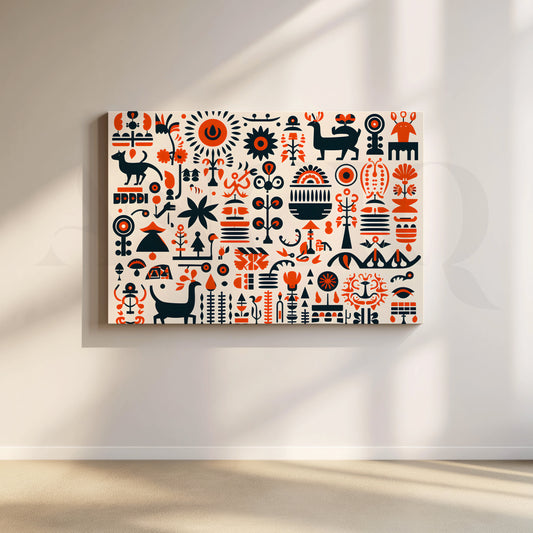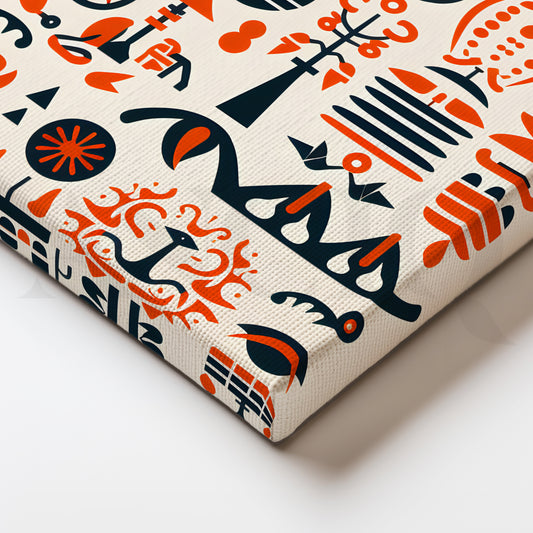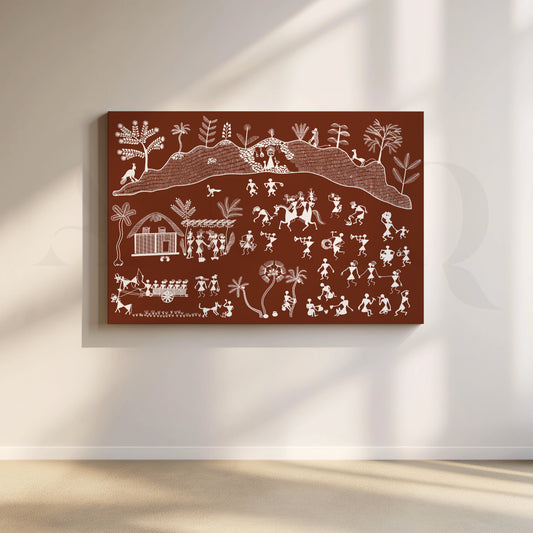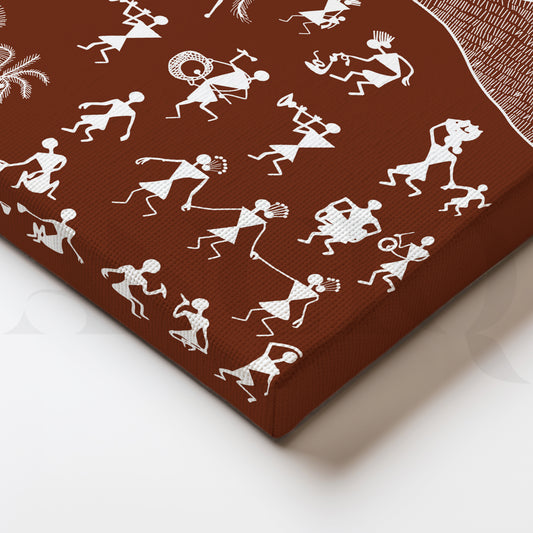Warli Art
- Featured
- Best selling
- Alphabetically, A-Z
- Alphabetically, Z-A
- Price, low to high
- Price, high to low
- Date, old to new
- Date, new to old
Frequently Asked Questions
Art inspired by Maharashtra’s Warli folk style—geometric human figures, nature, and village scenes—created by licensed artists and made-to-order in India.
Yes. We credit artists and reference Warli motifs respectfully. Public-domain bases are disclosed; otherwise, works are contemporary interpretations.
Original artworks: one-of-a-kind, artist-signed. Canvas prints: premium canvas stretched on sturdy wooden bars. Posters: premium art paper, ready to frame. Framed variants use premium polystyrene with rust-free hanging hardware.
No. We don’t offer custom sizes or frames. Please pick from the listed options on each product page.
Dust gently with a dry microfiber cloth; avoid direct sunlight, moisture, steam, and chemicals. Every order is made to order and shipped pan-India in protective, gift-ready packaging. If damaged in transit, share photos and order details for a fast replacement per our Returns & Shipping policy.
Warli paintings by Anciq
In a society that is rushing toward modernity, the earthy rhythms of traditional art have a potent fascination from the past. warli paintings is one of the oldest art styles in India and is a timeless representation of community, simplicity, and a connection to nature. At Anciq, we honour this age-old craft as a living heritage that tells stories for generations to come, in addition to being a visual delight.
Our warli inspired collections, which includes paintings combines traditional and modern design elements to create a rustic elegance and cultural coziness in contemporary homes.
Understanding Warli painting
Around 2500 BCE, the Warli tribe of Maharashtra created the tribal art form known as Warli painting. Warli stands apart from many colourful Indian folk arts because of its monochromatic colour scheme, which generally uses white pigment on an earthy red or ochre background. Geometric patterns such as squares, triangles, and circles are used to depict everyday life, farming, fauna, social gatherings, and cosmic beliefs.
Warli is really about telling stories; each painting is more than just ornamentation; it is a moving story that depicts the community's interaction with the natural world and the supernatural.
The role of symbols in Warli artwork
The fact that Warli expresses so much with so little is among its most intriguing features. The Warli painters express profound human feelings and experiences through simple shapes:
● Circle: represents the everlasting energies of life, the sun and moon.
● Triangle: Stands for trees and mountains.
● Square: A hallowed space utilized in ceremonies, frequently representing a house or territory.
● Dots and lines: Used to show movement, rain, or animal traces.
Two triangles linked at the tip are frequently used to depict human forms in order to convey symmetry and balance. Every character and component, whether in a wedding procession, harvest festival, or tribal dance, contributes to a greater beat, bringing people closer to their social and natural environments.
The significance of Warli in the modern world
Warli art serves as a subtle yet potent reminder of our heritage in the digital age. It appeals to viewers not just because of its minimalist style but also because of the principles it upholds: sustainability, communal life, ecological balance, and spiritual simplicity.
Tradition has a place in every house, according to Anciq, not behind museum glass but in ordinary décor that is recreated with carefully chosen pieces, handcrafted embellishments, and materials that are responsibly obtained and preserve the essence of Warli.
Why choose Warli paintings for your space?
Everlasting cultural legacy: With a history spanning more than 2,500 years, Warli painting is among the oldest tribal art traditions in India. This art style, which has centuries of history, folklore, and spiritual meaning, originated with the Warli tribes of Maharashtra. You're honouring a rich heritage and conserving indigenous culture when you incorporate a Warli artwork into your décor.
Minimalism that makes a statement: Warli art embodies minimalism through its use of simple geometric shapes, such as triangles, lines, and circles. Each artwork tells tales of farming, rituals, dancing, rural life, and the relationship between people and environment, and despite its simplicity, it is quite evocative. For contemporary houses that value simplicity but want for depth, it's the ideal option.
Natural charm and earthy tones: The natural colour scheme of Warli art, which is usually depicted in white on a red or brown mud background, goes well with earthy, rustic, bohemian, and even modern home design styles. Because of these soothing hues, Warli art is quite adaptable and looks great on neutral-colored walls, wood, stone, and terracotta.
How can you add the Warli element in your space?
Warli wall art: Our framed Warli wall paintings provide eye-catching focal points and are ideal for living rooms, corridors, or bedrooms. Each piece of art, which features traditional sceneries like dancing tribespeople, ceremonial circles, village life, and animals, is hand-painted by talented artists. They give ordinary walls character and warmth with their unprocessed textures and natural arrangements.
Warli decor accents: Candle holders, vases, wooden trays, ceramic planters, and other multipurpose home accessories with Warli themes are all examples of Warli décor. These are ornamental yet useful items that evoke discussion and give your house design a touch of tribal flair.
Warli tableware: What's the use of keeping tradition inside walls? With hand-painted bowls, coasters, and platters that honour community and unity, Warli dinnerware elevates your eating experience and is reminiscent of a Warli celebration held outdoors.
How to style Warli paintings?
Are you unsure about how to decorate your home for Warli? Here are a few suggestions:
● Boho minimalist: Wooden furnishings and neutral colour schemes go nicely with Warli's earthy hues. A Warli frame can be hung over a jute mat or combined with linen drapes and woven baskets.
● Rustic modern: To combine rustic and urban elements, pair a Warli sculpture or candle holder with metal accents and leather textures.
● Eclectic mix: To add layers of culture and design to an eclectic space, use Warli motifs on pillows, rugs, or tableware.
● Spiritual corners: Because of its rich spiritual connotation, Warli art is ideal for areas used for meditation or puja.
Design-based tradition preservation
We at Anciq are enthusiastic about making meaningful goods. We think it's important to ground ourselves in India's artistic legacy in a world that is changing quickly. Warli painting is more than simply a style decision; it's a means of reestablishing a connection with age-old knowledge, where each symbol has spirit and each brushstroke is a blessing.
Our goal is to bring forgotten customs back to life by giving them a fresh look that is grounded in traditional values but tailored for the modern world. Every Warli piece you bring home welcomes sustainability, narrative, and soul in addition to décor.
Bring Warli’s legacy home
A Warli painting is more than simply a work of art; it's a link to a culture that values spirit, community, and the natural world. Anciq offers you the opportunity to possess a piece of this heritage—not as a memento for collectors, but as a work of living art that permeates your daily existence.
Our Warli painting collection blends classic beauty with cultural depth, whether you're wanting to furnish a new home, create a mindful lifestyle, or find heartfelt presents.
Explore our whole collection and bring beautiful, sustainable, and heartfelt art home.






























